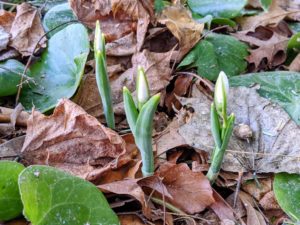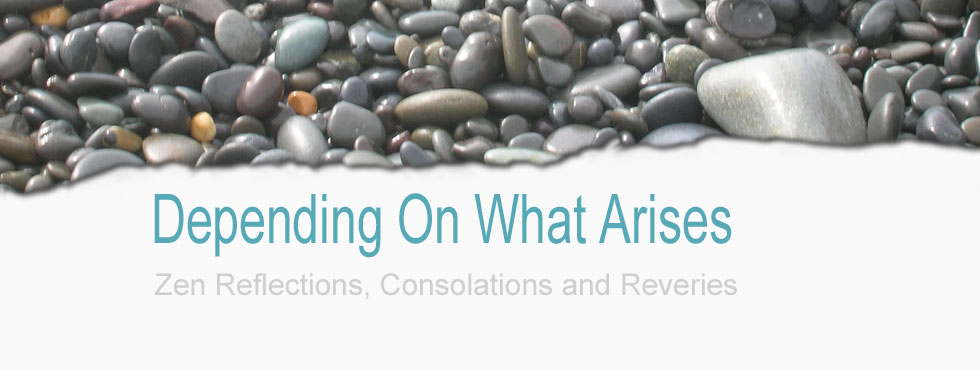Appreciating Mistakes
- At March 05, 2021
- By drynick
- In Reflections
 0
0
Dogen Zenji said shoshaku jushaku. Shaku generally means “mistake” or “wrong.” Shoshaku jushaku means to succeed wrong with wrong, or one continuous mistake . . . A Zen master’s life can be said to be shoshaku jushaku.
Shunryu Suzuki, ZEN MIND, BEGINNERS MIND
I often paraphrase this to say that the spiritual path is one mistake after another. Or perhaps it would be more accurate to broaden this to say that human life is one mistake after another. No matter how good or pure or mindful we intend to be, we can never outrun our blindness. Greed, anger, and ignorance rise endlessly. Our righteousness is always, at least in part, self-righteousness designed to protect our position and avoid our full humanness.
While this sounds rather depressing, when we look more deeply, it can actually be quite liberating.
There is no life apart from reactivity. In fact, reactivity is part of the definition of life. We might even say that to exist is to react. Even a mighty mountain, while apparently standing immovable, is eventually washed to the sea by the rain that falls. The great earth continually reacts and responds to the gravitational pull of the sun. And the sun is held and dances in response to her sister stars in the Milky Way and beyond.
We are all pushed and pulled by everything else. We are all being worn away by the winds and rains of our lives. (Not to mention the needs and desires of the people we have been cooped up with for the last year COVID precautions.) To exist is to be in relationship to the world around us. We reach out our hand to touch a smooth stone and we are touched by that very same stone. Life and non-life appear together. All life is supported and sustained by all life.
So what is this nonsense about mistakes? What is a mistake? ? Is it something I do that has consequences beyond my intention? If this is the case, then everything is a mistake. Every single action I take has implications that only unfold after my action and can never be known. Is a mistake something that harms others or doesn’t turn out how we intended? In this case too, all our actions must be included.
Of course, all our actions differ in their impact on those around us. Sometimes we do things that are clearly selfish, mean-spirited, and hurt others (and ourselves). Sometimes our actions seem beneficial and supportive to the life around us. We all should aspire to the latter and avoid the former. But this is impossible.
We can never know what comes from what we do. We must assume that any story we tell about who we are and what we are doing is inaccurate, biased, and limited. I might take an action motivated by kindness and generosity and only later discover that my actions created problems that perhaps even made this situation worse—or they may have helped the immediate situation but had a negative impact on some other situation I wasn’t even considering.
Only in acknowledging our incomplete awareness and the impossibility of moral purity, can we honestly commit ourselves to lives of kindness and compassion. We vow to do the best we can to keep our hearts open and to see as far as we can into our interconnection with all beings and with the planet. We examine our motives and stay alert to our bias toward self-righteousness. We practice listening to perspectives and positions that disturb us so as to learn what we do not yet understand. We act with as much integrity and conviction as we can muster.
Then we accept the consequences, both intended and unintended. We learn as we go. We practice apologizing. And we go on.
(Excerpted from forthcoming book Wandering Close to Home: A Year of Zen Reflections, Consolations, and Reveries. September 1, 2024.)
Another Chance To Remember
- At March 04, 2021
- By drynick
- In Reflections
 0
0
In this very moment is there anything more vital
than the beating of your heart and
the breathing of your breath?
In this very moment can you slow your separate urgency
long enough to appreciate the life
that effortlessly gives itself to you?
Where else would you go? Who else could you be?
The time you imagined has already arrived and
connection richly sustains us all without reservation.
You must stop this pretense of poverty and return
your longing to the beloved who is already you
and is already here—incarnate everything encountered.
The generosity of the life that is beyond comprehension
will certainly hold you and will just as certainly
someday soon enfold you again into the infinite source.
Certainly, certainly you are not separate. Each particular thing
is the boundless presence of life
offering you another chance to remember.
(Excerpted from forthcoming book Wandering Close to Home: A Year of Zen Reflections, Consolations, and Reveries. September 1, 2024.)
The Night Wind
- At March 03, 2021
- By drynick
- In Reflections
 0
0
All night the wind
convulses frozen trees
in a wild howling.
I sleep fitfully.
Just before midnight,
the doorbell rings
and digital clocks
begin flashing.
After noisy hours,
creeping light returns
and the wind drops.
We all stand still
for a moment
before great gusts
rise up to push again
against the walls of my room.
The acerbic sun
illuminates the bare
branches responding
with fresh spasms of delight.
Snowdrop Delight
- At March 01, 2021
- By drynick
- In Reflections
 0
0
My Love Note from February 25
When will you come
my nodding friends
alabaster snowdrops?
was answered on February 26! The flowers are still budded and not yet nodding, but that is perfectly fine with me.
I thought to look for them the day after I wrote, but was genuinely surprised to find them. There are a few secret places I know to look, where they come up every year. Usually I forget and they catch me by surprise, when spring is far from my mind with cold melting snow all around. I’ll be on a backyard excursion to check for something else and they’ll catch my eye by the path, in a patch of frozen ground. I wrote another love poem on March 18 in 2019 about snowdrops, the first flowers of the year in the Temple garden:
As the snow retreats
they surprise me every year
in the same place.
But, as I said, this year I remembered to look even while the snow blanketed 90% of the garden and grounds. And there they were by the lower entrance to the Temple. It’s not a particularly fertile part of the garden—nearly fully shaded by a spectacular crimson rhododendron that has risen beyond all reasonable rhododendron expectations and dominates the area. I have a couple painted ferns that seem to be happy underneath along with some ornamental ginger, but not much else seems to tolerate the shade and soil…except the hardy few snowdrops that return year after year.
After ten springs walking in this Temple garden, the larger patterns are just beginning to reveal themselves to me. This is the joy of gardening, to discover and work with the natural flow of things. The garden here has been a patient teacher. Though I am a slow learner, my stubborn enthusiasm keeps me around long enough to take in some small portion of the beauty and brilliance that surrounds me. The way things happen grows only slowly on and in me.
I am a great believer in the randomness of events. As we used to say in sociology, correlation is not causation—just because two events happen one after the other does not mean that one caused the other. I am a great believer in the staggering number of variables that lead to the occurrence of any single event. Freud called this overdetermination—there are a number of reasons why any particular things happens—each one is, perhaps, sufficient explanation, but not a full explanation.
Over the season and over the years things happen in a garden. Some plants flourish, some survive and many die. As a gardener, you are always working with failure and death. The plant that looked so healthy and lush at the garden center or in its glossy photo in the catalogue, looses its mojo when placed in what should be the perfect spot. Or it does well for a season or two, then mysteriously withers.
But in the middle of all the coming and going, a lot of things flourish—most of them not due to my care. I suppose that’s one of the criteria for succeeding in the Temple garden, to survive without a lot of fussing necessary. Now fussy plants are beautiful and we could also call them high relationship plants. Fussy is just the word of a lazy gardener who isn’t fully committed to the relationship.
We had a Zen student who had a thing with orchids. She would take our supermarket orchids after they had bloomed and before we took them to the compost pile. They would return several months later covered again with gorgeous blossoms. The orchids clearly delighted in her careful attention and she in theirs. The rescued plants would grace the Temple for weeks on end.
For me, however, I like the rough and tumble plants that, having found the right location, flourish with the proud neglect of a gardener who doesn’t like to work too hard—who just wants to appreciate the natural processes as they reveal themselves.
So the wild snowdrops have done quite well in the Temple garden and have finally taught me to look for them before I am even thinking about spring. I went down to the lower entrance on Friday afternoon, just on a whim because the snow was pretty much everywhere. (It was the day after writing my poem of longing for them, but usually I’m so busy longing that I forget to look for what is already here.)  There, in the small neglected area near the lower door was a small patch of ground not covered in snow. And there, to my delight and surprise, were the three first snowdrops of the year—each one just two or three inches tall, snuggled amongst the round wild ginger—holding aloft their white buds, almost ready for nodding.
There, in the small neglected area near the lower door was a small patch of ground not covered in snow. And there, to my delight and surprise, were the three first snowdrops of the year—each one just two or three inches tall, snuggled amongst the round wild ginger—holding aloft their white buds, almost ready for nodding.
Transitioning
- At February 28, 2021
- By drynick
- In Reflections
 0
0
This morning. I wake up in the dark with a sinus headache. It’s not terrible, but it’s not pleasant and I notice that I’m unconsciously clenched against the sensation. I feel not only the sinus ache underneath my eyes, but also a tightness in the whole area of nose, cheeks and eyes that feels like it extends to my brain. Now a little more awake in the dark, I turn toward this amorphous arising. It seems possible to release some of the generalized contraction around the ache itself. This reduces the unpleasantness and all I’m left with a dull sensation that’s surprisingly subtle and hard to describe.
Now, the urge to pee becomes strong enough to overcome the inertia of the beddrag* that entices me to stay under the covers. In a previously unpredictable moment, I uncover my formerly sleeping self, swing myself upright and make my way to the bathroom to pee, to the kitchen to make tea and finally to the living room to write.
Having turned up the thermostat when I started the tea, the heat now begins to come to the radiators. Here, in the front room, it comes with a pleasing hissing sound that reminds me of other houses and other cozy winter mornings snuggled reading or writing in a warm chair.  But from the back of the house, a familiar hammering sound begins. It’s only when the heat comes on, and it lasts for just a few minutes, but it’s like the carpenters are back and doing a small bit of noisy remodeling in the very early morning. Or like we have a ghost carpenter who got lost on the job and wakes up every morning for just a short time to complain and rail against his lot. He’s a water ghost and is trapped in the pipes of the heating system.
But from the back of the house, a familiar hammering sound begins. It’s only when the heat comes on, and it lasts for just a few minutes, but it’s like the carpenters are back and doing a small bit of noisy remodeling in the very early morning. Or like we have a ghost carpenter who got lost on the job and wakes up every morning for just a short time to complain and rail against his lot. He’s a water ghost and is trapped in the pipes of the heating system.
I imagine it’s not a bad life—no deadlines or responsibilities. He gets to do a lot of local traveling around the house and he’s constantly changing states from water to steam and back to water again. My theory is that he only minds the first transition of the day. When the early morning blast of steam comes to rouse him from his dark slumbers, he’s shocked and disturbed. In panic, he hammers frantically on the pipe to get out, but realizes, after a short time, that it’s more fun to be the dancing energy of steam than to complain. So, after a short tantrum, he sets his hammer down and abandons himself to the flow of what is happening.
But really, I know it’s ‘water hammer’ and has something to do with water that has not properly drained back to the furnace encountering the fresh steam from the furnace. The incoming steam ‘rapidly condense over a puddle of water causing the water to snap violently up into the partial vacuum left by the condensed steam.’ I can’t quite picture this alleged ‘violent snapping’, but I can certainly hear it.
Later this morning, I promise myself that I will go and do my best imitation of a handy-man and see if I can notice anything off about the pitch of the radiator or the pipe that serves both as the conduit for the steam to the radiator and the path for the cooler water on its return journey. Mostly, on these handy-man adventures, I see little and give up quickly, but you never know.
Meanwhile, I’ll do my best to surrender to the thousand transformations of state required through the day. From sitting to standing, from inside to outside, from confused to clear and back again. Of course, a little complaining and clenching is to be expected, so I’ll try to include that too and see what I can learn.
- beddrag – the feeling of reluctance to exit the warm comfort of the horizontal life of dreaming and enter into the vertical exertions of daily life. See February 20 ‘Discovering New States of Being’



Follow David!